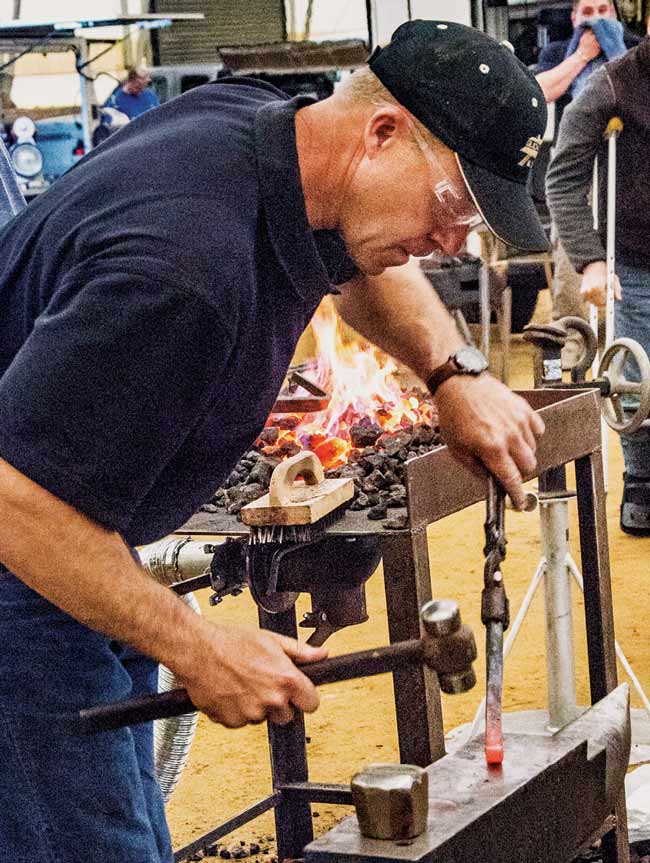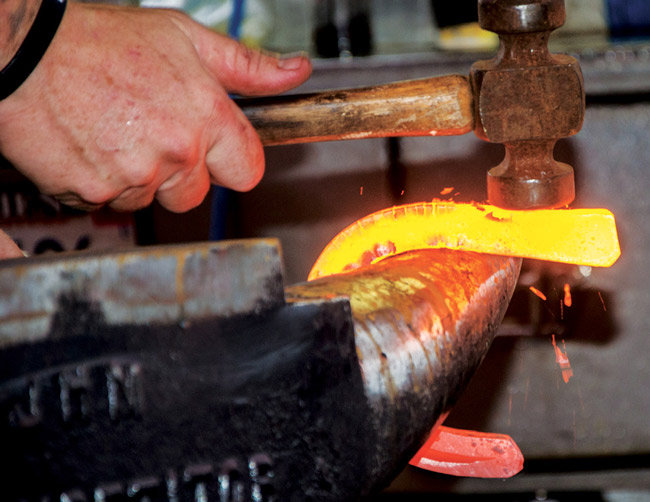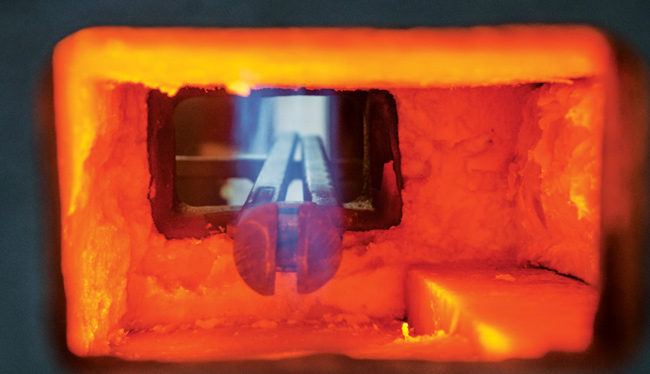If you’re a horseshoer, you work with metal every day. But how much do you have to really know about metallurgy — the science underlying the working of metal — to be successful?
That might depend on how you define success and what kind of farrier you want to be.
First, it’s clear that there are plenty of successful horseshoers out there who make a good living without really understanding the properties of metals, their production and purification, and how they come into play in heating and shaping.
But a pair of veteran farriers with more than a passing knowledge of metallurgy believes there is still an important place for this knowledge in the industry.
Mitch Taylor believes that if you’re serious about being a farrier, knowledge of metallurgy is vital. Iron and steel, he says, are the muscle and bones of the profession.
“Steel is our medium,” says the owner of the Kentucky Horseshoeing School in Richmond, Ky. “It’s what we work in every day.”
Jim Quick, a veteran farrier from Longmont, Colo., with a shoeing book that includes many top show horses, is also known as a top shoeing competitor with a reputation as a handy toolmaker. He believes his knowledge of metallurgy and tool making helps him to do the job better.
Farrier Takeaways
Understanding metallurgy will help you better understand what’s going on as you forge and shape a shoe.
Being able to make and adjust your own tools not only will help you work more efficiently, it can be much less expensive than buying them.
Working with worn-out tools will cost you efficiency and can be unsafe.
“Horseshoeing is a difficult enough job and if you have lousy tools, it’s even tougher,” he says. “I want to make the job as easy as it can be, and one of the things that certainly helps is having high-quality tools that work properly.”
In separate interviews, Taylor and Quick discussed a variety of reasons they think farriers benefit from understanding metallurgy, some practical and some more esoteric. Interestingly, they both mentioned understanding metallurgy as part of “owning the trade.”
Part And Parcel
“There is more to being an accomplished farrier than just tacking keg shoes onto a horse’s foot,” says Taylor. “I’m a big believer that if we don’t continue to learn our trade, we won’t own our trade.”
Taylor believes a failure to own the trade has contributed to trends such as more veterinarians going into podiatry and the barefoot movement, particularly that segment made up of owners who opt for boots instead of shoes for protection.
“We’ve indirectly created a void or a vacuum by not having a full understanding of our trade, which includes metallurgy,” says the International Horseshoeing Hall Of Fame member.
Quick takes pride in a compliment offered to him by Craig Trnka, the New Mexico farrier who leads the World Championship Blacksmiths organization.
“He watched me shoe a horse with bar shoes once and told me, ‘You own your trade.’ I asked him what he meant and he said, ‘You made a pair of bar shoes out of bar stock with tools you made yourself and you nailed them on the horse,’” recalls Quick.
At the Kentucky Horseshoeing School, Taylor says he stresses the importance of having a full understanding of the business of hoof care.
“I believe a farrier should not only know how to trim horses, know anatomy and understand biomechanics, but should also know a little bit about blacksmithing,” he says. “And metallurgy is a part of blacksmithing.”

Tool making ultimately helps Jim Quick properly shoe a horse. “Horseshoeing is a difficult enough job and if you have lousy tools, it’s even tougher,” he says.
Where To Learn
There are a number of ways farriers can attain basic knowledge about metallurgy.
Quick notes that there are good chapters on the topic in The Principles Of Horseshoeing III, the oft-cited textbook by Doug and Jacob Butler. He also learned — and continues to learn — by “hanging out,” as well as competing with farriers who are expert toolmakers, like Jim Poor, Jay Sharp and Shayne Carter.
Students at the Kentucky Horseshoeing School get two lectures on metallurgy. The lessons cover topics such as how steel is made, what alloys are and how they differ.
“We want them to understand that if they get a piece of 4140 manganese steel, it has 40 points of carbon in it,” says Taylor. “They understand that means it’s pretty hard and they’ll have to work it within the correct forging window.”
Along the way, students pick up some knowledge about tool making as well.
“If they are going to make a forepunch, they have to understand that there’s a forging window there, a temperature range when they can forge it,” he says. “If the steel hasn’t reached that window, you can still forge it, but it will have a bunch of micro-fractures in it. It won’t be a good tool for very long and could eventually fracture.”
Tools Of The Trade
Taylor and Quick both agree that knowledge of metallurgy makes the biggest difference when it comes to being able to make and maintain tools.
“We have a lot of guys who just go out and buy tongs today,” Taylor says. “That was one of the first things you did when you first started apprenticing as a blacksmith — learned how to build fire tongs. Building your own tools, especially things like tongs, punches and pritchels, were part of the learning process.”
Each of those tools, Taylor explains, might be built with steel of a different hardness. It’s important to take into consideration how a tool will be used and make sure that the choice of steel is going to be able to withstand the forces it will be subjected to. That requires a certain working knowledge of metallurgy.
“Let’s say you put a lot of work into making a pair of tongs, but you make them out of mild steel,” says Taylor “When that steel gets hot, it loses its shape and will also lose its grip on the shoe you’re working on. That’s why, instead of making tongs out of mild steel, we make them out of 4140, which is not a tool steel necessarily, but what is called a medium- or high-carbon steel.”
Quick says tongs are an excellent example of the importance of understanding how tools are made.
“Almost all horseshoers use tongs, and most guys are using tongs that are poorly adjusted and don’t work well,” he says. “A good quality pair of tongs that are properly adjusted just make the work so much easier. Being able to make your own tongs is a great skill to have. I’ve had times when I stopped in mid-project and made a new pair of tongs, then went back to the project with the right tool for the job.”
If we don’t continue to learn our trade, we won’t own our trade …
Tongs also provide a good example of another advantage that farriers who can make some of their own tools have over those who buy them. They can save money.
“Tongs, fullers, stamps and pritchels are all tools that don’t last forever,” says Quick. “It gets pretty expensive to go out and purchase a new one every time one wears out. I can make a head stamp in just a few minutes and when it gets torn up 6 months down the road, it doesn’t bother me a bit. I chuck it in the trash and make a new one.”
Taylor says that toolmakers are the people in the business who have the best knowledge of metallurgy. He says one of their trademarks is having a set of tongs for every job.
“If you go to their shops, they typically have hundreds of tongs,” he says. “And once you mastered the ability to make a simple pair of flat-jawed tongs, it’s easy to learn to build all the other kinds of tongs that are useful in this business.”
The Hardness Facts
Taylor believes farriers will benefit from having at least some understanding of how the hardness of steel is measured.
One measure of hardness is called the Rockwell Scale. In this method, a machine drops or presses a ball of tungsten carbide or some other hard substance into the steel and the resulting divot or dimple is measured. A small change results in a higher Rockwell score.
There are practical benefits from understanding these measurements.
“Your anvil should be a little bit softer than your hammer, so that if you miss a shoe, the anvil will take the blow and gives or dents a little, but doesn’t chip,” explains Taylor. “And because the hammer is harder, you won’t have a piece of it flying off at high speed.”
Taylor says that hammers and tongs should be about the same Rockwell hardness, but tools that are going to be struck — punches, pritchels and fullers — are going to be much harder.
Hammer faces that are too soft are more likely to mushroom and ultimately chip. A chipped hammer face is not only less effective at doing its work; those flying chips can cause serious injury to an eye.
Steels For Tools
Quick and Taylor both say that most tool makers have moved to using S-7 steel for all tools and away form H-13 steel. S-7 steel is a tool steel, noted for toughness, strength and wear resistance. H-13 steel is alloyed with chromium, molybdenum and vanadium to make it less deformable when heated, while still retaining strength.
Quick says the two steels are “pretty interchangeable,” but says there was once a rule of thumb that S-7 steel was used for tools designed to be struck (pritchels, punches, fullers, etc.) and H-13 steel for tools that were designed for hot work.
Quick says part of the reason for this was it became more difficult to get high-quality H-13 steel.
“A lot of foundries stopped making it,” he says. “It wasn’t as good as it used to be and you’d sometimes get a bad piece. That can happen with any steel, but it led to a lot of guys changing to using just S-7 steel.”
Taylor says H-13 steel is a little harder and holds up better than S-7 steel, but he says it’s also a little harder to work and to heat treat. He also believes liability issues might also have come into play in the movement toward more S-7 steel.
“The S-7 steel is a little more reliable when it comes to fracturing,” he says. “When steel fractures while hitting it with a hammer, pieces can fly off of it and that’s dangerous.”
The type of steel in a tool also comes into play when repairing or adjusting tools, says Quick.
“One of the critical things about 4140 steel is that if you quench it while there is still any color in it, it will get really hard,” he says. “That means it gets brittle and it can snap.”
Tongs often are made from 4140 steel. Quick says if you heat up a pair of tongs to adjust them, you need to let them air cool. If you don’t, they’re likely to snap the next time you use them.
Quick says tool making ultimately helps him in his main goal: Properly shoeing a horse.
LEARN MORE
Quick demonstrate how to forge a heart-bar shoe by visiting americanfarriers.com/0717
“I don’t want to make a fuller so I can sleep with it under my pillow. It’s just a tool,” he says. “I always say I don’t really want a fuller, what I want is a fullered shoe. And I don’t really want a fullered shoe. I just want the horse shod, and I need the fullered shoe to do that.”
Quick also believes that much of the knowledge involved in the trade is inter-related.
“To understand how a fullered shoe helps a horse, it helps to understand how to fuller a horseshoe,” he says. “If you want to know how to fuller a horseshoe, it helps to know how to make a fuller. It all goes hand-in-hand.”

As heat is added and steel reaches a critical temperature, electrons and protons jump out and trade with other molecules, creating the ability to forge it, Mitch Taylor says.
What About Shoes?
Quick and Taylor both say a knowledge of metallurgy isn’t as important as it once was when it comes to actually heating and shaping horseshoes.
“There are manufactured concave shoes available that are as good as anything you’re going to be able to make,” Quick says. “It’s just completely impractical to hand-make shoes for every horse.”
Most so-called “steel” shoes actually have a quantity of tin, lead or some other material added to the steel to make it easier to work with.
“That makes the steel softer, so that you can shape it cold,” he says. “You can’t really forge it cold, but you can shape it. It’ll move, get smaller so that it fits the foot. But after a while, it will start fracturing. We can take the same shoe, heat it up and forge it into the shape we want without injuring it. When you cold shape, you’re actually damaging the internal structure, but not to the point that it will break.”
Taylor says shoe manufacturers take how farriers work into consideration. When he started shoeing, he said it was important to let most shoes you had heated in the forge cool gradually.
“Like everything, steel is made up of molecules. The electrons and protons of those molecules are held in place by a magnetic force. They can’t get out of the electron shell,” he explains. “But as heat is added and the steel reaches a critical temperature, the steel loses its magnetic polarity and electrons can jump out of the electron shell and trade with other molecules. That’s why we can forge it. We can take a piece of steel and forge it to the width of a hypodermic needle if we keep it hot.”
But quenching steel from that critical state quickly, by plunging it into cold water, for instance, will harden it, but also make it brittle.
“When we do that, all those molecules freeze and can’t go back into a normal electron shell and grain structure. Within that steel, there is now a high degree of tension. I can take that shoe or mild piece of steel and crack it with my hammer and it will fracture,” says Taylor. “And if you look at where it cracks, the grain structure will look very different from steel that you’ve allowed to cool more slowly. It will be very crystalline looking.”
Horseshoe manufacturers realize that farriers are going to quench hot shoes quickly, according to Taylor, and have dealt with the problem by alloying the steel with other metals that made the metal less brittle when quenched.
When Quick started shoeing some 30 years ago, keg shoes were pretty basic.
“You couldn’t buy a bar shoe and you couldn’t buy clipped shoes,” he recalls. “If you wanted to get ahead in this business, you had to be able to weld your own bar shoes and draw your own clips. Now you can go to a supply store and they have an unlimited supply of both.”
While manufactured bar shoes are now available, Quick says that’s one shoe he still builds himself.
“I don’t have to use bar shoes that often, so I don’t want to buy a whole stock of them,” he says. “Craig Trnka always says, ‘Lack of skill weighs down your truck.’ I’ve even had a veterinarian call me and tell me he wants a patten bar shoe on a horse. I had him take some measurements for me and give them to me over the phone, and then I built the shoe in my shop in the morning before I went to the clinic. I was only at the clinic for about 15 minutes and everyone was happy.”
Taylor points out that it’s in situations like that one when knowledge of metallurgy and shoe making does come in handy. He says it’s also the kind of work that is done by higher-end farriers, who have put in the extra time to learn that aspect of the craft. It can pay off financially, as well as in a feeling of accomplishment.
If you are interested in competing, or in passing higher levels of certifications, understanding metallurgy will help you and may be vital. Quick believes that well-made tools can be the difference between passing or failing a certification test or in placing high in a contest.
Quick recalls competing in the two-man competition at Calgary with Jim Poor, the well-known farrier and toolmaker who owns Flatland Forge in Midland, Texas.
“We spent a weekend making the tools we needed and we made one pair of shoes,” he says. “Then we went to Calgary and beat a lot of guys that had practiced by making hundreds of pairs of shoes.
“We had better tools. That’s always been my approach. When I’m preparing for a competition, I spend far more time preparing my tools than I ever do making the shoes.”









Post a comment
Report Abusive Comment